Book contents
- Frontmatter
- Contents
- List of tables and figures
- Preface
- Acknowledgements
- List of acronyms
- Notes on contributors
- 1 Introduction
- 2 Inequalities in income, wealth and standard of living in Britain
- 3 Inequalities in employment: problems of spatial divergence
- 4 Educational inequalities and Education Action Zones
- 5 How can we end inequalities in housing?
- 6 Tackling inequalities in crime and social harm
- 7 Poverty across the life-course and health
- 8 Inequalities in health service provision: how research findings are ignored
- 9 A mortality league table for Cabinet ministers?
- 10 Ending world poverty in the 21st century
- Index
10 - Ending world poverty in the 21st century
Published online by Cambridge University Press: 05 July 2022
- Frontmatter
- Contents
- List of tables and figures
- Preface
- Acknowledgements
- List of acronyms
- Notes on contributors
- 1 Introduction
- 2 Inequalities in income, wealth and standard of living in Britain
- 3 Inequalities in employment: problems of spatial divergence
- 4 Educational inequalities and Education Action Zones
- 5 How can we end inequalities in housing?
- 6 Tackling inequalities in crime and social harm
- 7 Poverty across the life-course and health
- 8 Inequalities in health service provision: how research findings are ignored
- 9 A mortality league table for Cabinet ministers?
- 10 Ending world poverty in the 21st century
- Index
Summary
At the end of the 1990s the reports from different international agencies on the progress made in reducing poverty seem to blow hot and cold – and provoke public bewilderment. On the one hand, there are claims of unprecedented success for human development. During the last 30 years life expectancy has grown in all regions of the world and in some poor regions has grown spectacularly. Rates of infant mortality and of underweight children aged below five have declined. More people in most countries have gained access to safe drinking water. Levels of adult literacy and school enrolment have improved – although the rates are still relatively low in many of the poorest countries. With marked fluctuations there has been economic growth in the last three decades in poor as well as rich countries – and average living standards have improved (UNDP, 1997, 1998, 1999; World Bank, 1999a; DfID, 1997).
On the other hand, the incomes of the richest 20% grew faster than those of the poorest 20% of the world's population between 1960 and the 1990s, the comparative increase being in the ratio 30:1 in 1960 and 74:1 in 1994 (UNDP, 1997, p 9). Inequality widened within many countries as well as between groups of rich and groups of poor countries. Population numbers living on less than $1 per person per day remained stubbornly high in many developing countries. “Nearly 1.3 billion people, about one-quarter of the world's population, live on the equivalent of about $1 a day or less at 1985 international prices, or roughly the equivalent of $1.50 a day at 1997 prices in the US.” Nearly or more than half the populations of 16 countries, including India, Kenya, Guatemala, Nepal, Zambia, Ethiopia, Uganda, Rwanda, Zimbabwe and Nicaragua, live at this low level. Over a fifth of the population of China live on below $1 a day and as many as 58% below $2 a day (World Bank, 1999a, pp 196-7). Altogether “nearly 3 billion people, roughly half of the world's population, subsist on the scarcely more generous figure of $3 a day at 1997 US prices” (World Bank, 1999a, p 117; see also DfID, 1997, pp 9-11). The poorest 20% had only 2.3% of global income in 1960 but this had more than halved to 1.1% in 1994 (UNDP, 1997, p 9).
- Type
- Chapter
- Information
- Tackling InequalitiesWhere Are We Now and What Can Be Done?, pp. 211 - 232Publisher: Bristol University PressPrint publication year: 2000



